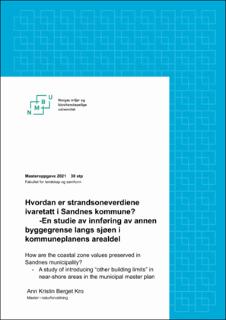| dc.contributor.advisor | Stokke, Knut Bjørn | |
| dc.contributor.author | Kro, Ann Kristin Berget | |
| dc.coverage.spatial | Norway, Rogaland, Sandnes | en_US |
| dc.date.accessioned | 2021-12-29T11:24:59Z | |
| dc.date.available | 2021-12-29T11:24:59Z | |
| dc.date.issued | 2021 | |
| dc.identifier.uri | https://hdl.handle.net/11250/2835567 | |
| dc.description.abstract | Strandsonen, definert som 100-metersbeltet langs sjøen, er gjennom bestemmelsene i plan- og bygningsloven § 1-8 gitt et nasjonalt vern. Siden 1965 har det vært et generelt byggeforbud i strandsonen for å hindre en «bit for bit» utbygging, og for å ivareta strandsoneverdiene. Disse er definert som natur- og kulturmiljø, friluftsliv, landskap og andre allmenne interesser. Til tross for at strandsonen er definert som spesielt viktig, er byggeforbudet ikke absolutt og kan fravikes gjennom lovgivningen i plan- og bygningsloven. I henhold til § 1-8 tredje ledd kan kommunen fastsette annen byggegrense i plan, og dermed nyanseres det generelle byggeforbudet i strandsonen. Byggeforbudet kan også fravikes gjennom dispensasjonshjemmelen i § 19-2.
Sandnes kommune i Rogaland har benyttet seg av bestemmelsen i plan- og bygningsloven § 1- 8 tredje ledd og fastsatt annen byggegrense i kommuneplanens arealdel. Dette omfatter arealer regulert til fritidsbebyggelse og byggeformål bolig og/eller annen bebyggelse. Fastsetting av annen byggegrense skal bero på en kunnskapsbasert vurdering av strandsoneverdiene.
Denne oppgaven belyser kunnskapsgrunnlaget som er lagt til grunn for fastsetting av annen byggegrense i arealene avsatt til fritidsbebyggelse. Det legges særlig vekt på vurderingene og kunnskapen som er benyttet av hensynet til naturmangfoldet i områdene hvor byggegrensen er innført. Studien viser at motivasjonen for å innføre byggegrensen var å redusere behovet for dispensasjonssøknader for tiltak i strandsonen. En bakenforliggende årsak til dette var at Sandnes kommune vedtok bestemmelser om økt hyttestørrelse ved rullering av kommuneplanen i 2019. Det ble her bestemt at det skal tillates hytter på inntil 100m² i strandsonen i områder avsatt til fritidsbebyggelse. Videre viser studien at denne bestemmelsen har vært førende for arbeidet med fastsetting av byggegrensen. | en_US |
| dc.description.abstract | The coastal zone, an administrative zone defined as a 100-meter-wide belt along the Norwegian shoreline, has been granted national protection through the provisions of the Planning and Building Act § 1-8. Since 1965, there has been a general building ban in the coastal zone to prevent a "piece-by-piece" utilization of the areas, and to protect the coastal zone values. These values have been defined as nature and cultural heritage, outdoor life, landscape and public interests. Even though the coastal zone is defined as nationally important, the building ban is not absolute and can be deviated from through the legislation in the Planning and Building Act. In accordance with § 1-8, the municipality may set an “other building limit”, nuancing the general building ban in the coastal zone. The building ban can also be deviated through the dispensation authority in § 19-2.
Sandnes municipality in Rogaland applied the Planning and Building Act § 1-8 to set other building limits in the Municipal master plan’s land use part. This includes areas regulated for cabins, as well as “construction purposes for housing and/or other development”. When setting other building limits, a decision should made based on an assessment on the impacts on the coastal zone values, a so-called knowledge-based decision.
This thesis investigates the knowledge used as a basis for determining other building limits in areas regulated for cabins. The main focus is on the assessments and knowledge used when considering biodiversity in the areas where the other building boundary has been introduced. We find that that the motivation for introducing other building limits is to reduce the need for exemption applications for construction in the coastal zone. An underlying reason for this was that the municipality increased the maximum allowed cabin size when revising a new municipal plan in 2019. Now, a cabin footprint of up to 100 square meters is allowed in the coastal zone in areas set aside for cabins. This study also finds that the increased cabin size area legislation has affected the work on determining other building limits. | en_US |
| dc.language.iso | nob | en_US |
| dc.publisher | Norwegian University of Life Sciences, Ås | en_US |
| dc.rights | Attribution-NonCommercial-NoDerivatives 4.0 Internasjonal | * |
| dc.rights | Attribution-NonCommercial-NoDerivatives 4.0 Internasjonal | * |
| dc.rights.uri | http://creativecommons.org/licenses/by-nc-nd/4.0/deed.no | * |
| dc.title | Hvordan er strandsoneverdiene ivaretatt i Sandnes kommune? : en studie av innføring av annen byggegrense langs sjøen i kommuneplanens arealdel | en_US |
| dc.title.alternative | How are the coastal zone values preserved in Sandnes municipality? : a study of introducing “other building limits” in near-shore areas in the municipal master plan | en_US |
| dc.type | Master thesis | en_US |
| dc.description.localcode | M-NF | en_US |

